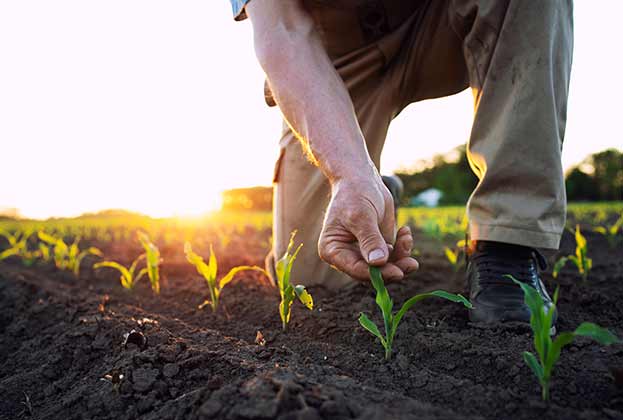Portugal has become one of the most popular destinations for institutional agricultural investment
With an increasingly reliable water supply improving the capacity of productive land to grow more than just arable crops and extensive livestock, Portugal is an attractive investment opportunity for an increasing range of food crops.
Main production regions
The north of Portugal is more dominated by forestry and vineyards whereas most large-scale productive agricultural land is located in the centre and south of the country. This is partly a reflection of the different topography within Portugal, with the north generally being more mountainous but also reflects the existence of large-scale public irrigation schemes in the south. As a result of this, it is much more common to find larger holdings (of 200 hectares or more) of farmland in the south of the country.
The traditional centre of Portuguese agriculture is in the Tagus basin, an area of flat, fertile, silty land on the banks of the Tagus River to the north of the capital Lisbon. The main crops there are olives, wine grapes and root vegetables. Most parts of the country lend themselves to the production of olives and tree nuts (almonds and walnuts) with the far southern Algarve region additionally popular in recent years for berries and avocados. The south west is a centre of winter production for salads and berries. Pistachios are grown more in the central region of Castelo Branco, where the slightly colder winter temperatures are more suitable.
Climate change risk
Rainfall in the major agricultural production regions of Portugal has typically been lower than in northern Europe. This has advantages and drawbacks. Disease pressure can often be less, which can be crucial for growers of high-value crops, and issues with field working logistics as a result of rainfall can largely be avoided. For tree nut crops this is also advantageous, as damage to flowers during the crucial bloom period in the spring can be minimised.
The lack of rain has traditionally not affected crop water availability. While groundwater sources in the south of Portugal are generally not considered reliable, the high water demands of vegetable, fruit and nut crops are predominantly supplied by irrigation water. The exception to this is in the Tagus basin, where the high water table lends itself well to plentiful groundwater supplies.
Investment begets investment
The level of water security, new irrigation schemes, together with the additional voluntary water governance of the Alqueva Infrastructure Development Organisation and the availability of large-scale farms in the area, have created an environment which continues to attract investors and offer opportunities as productivity has moved beyond just cereal and extensive livestock production.
Investors have been able to acquire irrigated land at scale and develop large tree crop orchards using global best practice. The first wave of investment was concentrated in the Odemira area of southwestern Portugal, where UK and northern European growers invested in land for the winter production of leafy salads and berries, with crops such as rocket, spinach and raspberries enjoying a particular competitive advantage over Spain and the rest of Europe.
The opening of the Alqueva irrigation scheme was the catalyst for increasing levels of interest from foreign investors in Portugal. Many of the earliest investors in land irrigated by the Alqueva scheme were Spanish, taking advantage of the cross-border land value differential and bringing with them centuries of incremental developments in crop husbandry.
More recently, investors from countries such as the UK, the USA, Switzerland, Canada and Chile have arrived. This concentration of capital has led to increasing investor interest in other areas of the country making Portugal – despite its relatively small land area – a European world producer and exporter of several crops for which demand continues to grow.
The opening of the Alqueva irrigation scheme was the catalyst for increasing levels of interest from foreign investors in Portugal
Jonny Griffiths, Savills Head of International Farmland
Savills estimates that, over the past twenty years, investors have acquired around 100,000 hectares of farmland in Portugal. A large part of this focus has been in the Alqueva region, but other regions such as Castelo Branco, the Tagus basin and north-eastern Evora county (around the towns of Elvas and Campo Maior) have also been popular. In the Alqueva region, prices for bare land with irrigation from the scheme trade at values up to (and indeed occasionally above) €30,000 per hectare, having been at levels closer to €15,000 per hectare around the time when the water first came on stream around 2008. Land without irrigation water (or with irrigation water from unreliable sources such as creeks) trades at around €5,000 per hectare. In other irrigated regions, such as Castelo Branco, values are less elevated, but are typically around €20,000 per irrigated hectare, with transacted values occasionally reaching up to €25,000 per hectare.
Investment returns
Investing in agriculture can generate returns in two ways; through an annual income, either from leasing or directly operating, and through appreciation of the underlying farmland asset. In Portugal, land price appreciation is less significant than in other geographies; this is mostly connected to the fact that many of the assets contain a significant depreciating component, such as biological assets, irrigation systems, greenhouses or polytunnels, which often offsets the appreciation of the underlying land.
Farmland investment returns in Portugal are dominated by the annual cash yield component. Cash yields range from around 7% for leased olive orchards through to 12% or higher if operational risk is taken with crops such as avocados or almonds. This cash yield component gives a degree of predictability to the return profile.
Read the articles within Spotlight: Global Farmland below.
.jpg)


